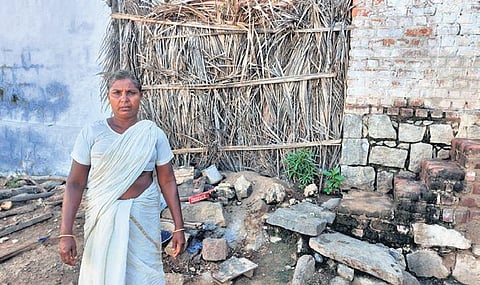

VIRUDHUNAGAR: Aficionados of Ki Rajanarayanan may be familiar with the central plot of his novel ‘Gopalla Gramam’ where the family of Chenna Devi escaped from the clutches of a king who wanted to take her as one of his wives. However, with slight tweaking in the storyline, a set of people in Ilanthaikulam village of Watrap believe that they are direct descendants of one such family that escaped a king’s wrath and was saved by a goddess named ‘Bommi’. The family and their descendants believe that they must only wear white dresses, to date, and carry on the story to the next generations.
The villagers said ‘those who wear a white dress’ live in a particular street and that they do so for a religious belief. When TNIE visited the street, one Panjavarnam (47) - wearing a white clothes - was cooking outside her house. In a place where women wearing pure white is seen as an inauspicious thing, Panjavarnam said they do so happily because of the belief that a goddess rescued their ancestors from the sexual violence of a king.
The legend goes like this: A long time ago in a village bordering Madurai, there was a white king who was abducting an unmarried girl from each house on a rotational basis. “When the turn of our forefather’s house came, they escaped as a family. All of them covered themselves in a white veshti and escaped the village, with the king’s horsemen chasing them. However, they met with a river. At that time they started praying feverishly to all the gods in the world to save them and their daughter. And then the miracle happened,” said Panjavarnam.
With an ecstatic tone, she continued, “A palm tree on the other side of the bank bent completely making a bridge for the family to cross the river. Once they crossed the river, the tree returned to its normal shape. But the horsemen were stuck on the other end, and the river started overflowing with water all of a sudden. By that time the entire family had escaped. What happened the next morning was the reason for all of us to wear white till date.”
Here is an excerpt from Ki Rajanarayanan’s book that describes the miracle: “Goyindappa... Goyindappa... It was then that this miracle happened. A huge peepal tree, on the opposite bank, as tall as a temple tower, bent towards us, on this side. First, we thought the tree had been uprooted and was thus falling into the river. Its branches touched the shore, stayed still for a while and it straightened up. Then it struck us that this was divine intervention. The one who guessed this the fastest was grandmother. The tree bent once more towards us.
“My children, my folk, hold on to the branches of the tree. It will save us and take us to the other shore,” she cried. We did this. As the horsemen came closer, the tree began to straighten up. So great was our happiness that we might have let go of the tree!”
As the people did not know which god saved them, they prayed collectively and cooked rice. When they were eating the rice, a seven-year-old girl appeared before them. But alas, the child fell into the fire of the stove. “They tried to save her but the girl asked them not to touch her. Who would not save a child from the fire? So they touched her and she said ‘you and your descendants must wear white to live healthily’ and died. We believe that the girl was the incarnation of the goddess who saved our family. She was named Bommi” Panjavarnam added.
A temple for Bommi Amman exists in a village near Peraiyur, where legend states that the said family crossed the river. Also, all the first children of all of the houses who worship this goddess are named ‘Bommi’. Though all of them lived as a tight-knit group in the said village for a while, they started migrating to other places for their livelihood, and that was how Panjavarnam and the other families ended up in Ilanthaikulam.
The people not only strictly follow the ‘white dress’ rule but also believe that something untoward will happen if they wear even a piece of coloured clothing. “Even if we buy a colour dress, it gets burnt automatically and no man in our families wears even the political parties’ veshti with coloured borders. Only the children wear the school uniform,” said the people.
While witnessing an incident and weaving it into a story is an experience, witnessing a real-life enactment of a story exactly as it is, is an altogether different experience. To those Ki Ra readers, this legend yet again proves that his works indeed documented the lives of the people of ‘Karisal Bhoomi’ of southern Tamil Nadu in their authentic language, as well as their folklore and beliefs.